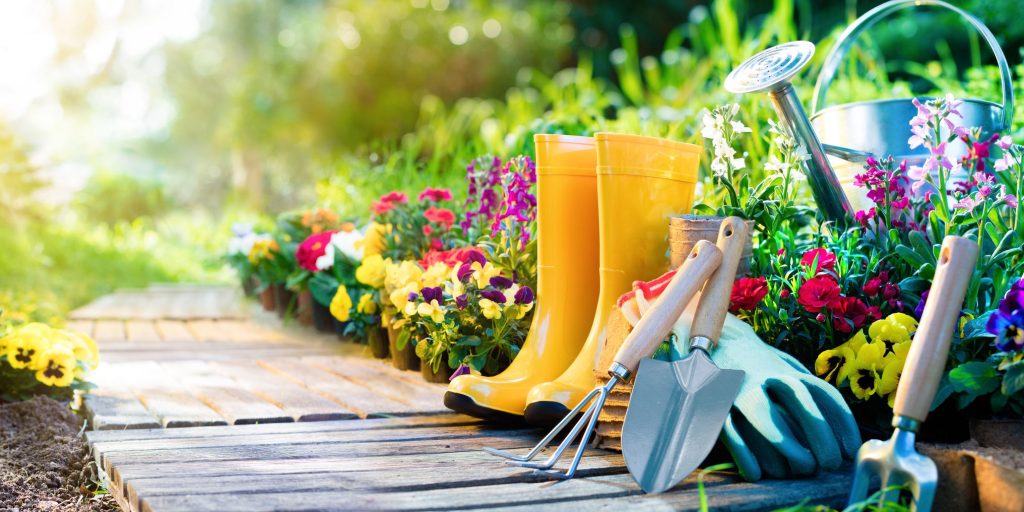 As spring temperatures warm up, gardeners rev up.
As spring temperatures warm up, gardeners rev up.
Whether you are a novice or an old garden hand, the urge to get outside and start digging in the dirt is overwhelming. So is the urge to spend money on plants, containers and gadgets.
And retailers, from big box stores to online vendors, are working overtime to make you forget everything except those compelling images of big beautiful roses or ginormous tomatoes.
But how do you create a nice plot of land, without depleting your budget? We chatted with a gardening pro to give you some tips.
1. Make a List
Just as you’d never grocery shop on an empty stomach, horticulturist Laura Roberts, garden manager at the Van Vleck House & Gardens in Montclair, New Jersey, advises gardeners to make a list of their most-needed plants before going shopping. Garden center plant pallets—especially those alluring ones in front—are laden with big, flashy specimens intended to disable the frugal part of your brain. “Don’t fall in love at the garden center,” warns Roberts. Not sure quite what you want to plant? Start with a color palette: This cool gardening color wheel gives you a dozen options, from complementary colors to narrowing down to a particular hue.
2. Shop Smarter
Your local gardening store may be laid out adorably, but you’ll likely get more bang for your flower buck elsewhere. First, time your purchase based on where you’re shopping: Plants at big box stores often receive only minimal care and are best if purchased within a few days of delivery. Call the store to find out which day most of their plants are delivered, then time accordingly. Also, check garden center websites for daily and weekly specials, and put yourself on a few online vendors’ e-mail lists to receive notices of limited-time offers and sales. Some may offer deep discounts (“$100 off your next order”) if you buy one plant early in the season.
3. Pick Investment Plans
Choose hardy, easy-care perennials, like daylilies, which come back every year and increase in size over time. Roberts especially likes the many varieties of sun-loving sedums and shade-tolerant hostas, which come in a whole variety of shades. Self-seeding annuals like larkspur and California poppies also return year after year.
4. Plant What Creeps and Spreads
Have, literally, a lot of ground to cover? Rather than spending half of your take-home pay on plants, be strategic and invest in a creeper. Better yet, weeds will be less likely to flourish if you provide green groundcover. Roberts suggests woodland phlox, lilyturf or ferns for this purpose. Hostas (above) also work. They don’t creep, but they do get large and you can split them up and replant them.
5. Seek Out Chic-but-Cheap Planters
If you’re planting a container garden, often the most expensive part is the pot you put it in. First, decide what color flowers you’re planting, and what accent color you’d like to present on your porch, deck or patio. Fun and inexpensive options abound at places like IKEA, West Elm and Walmart—or there are plenty of ways to transform a plastic container with a little DIY.
6. Consider Four-Season Interest
Some plants and hardworking shrubs do quadruple-duty, providing four seasons of interest in the form of flowers, colorful fruits, vibrant leaf colors and interesting bark hues and textures. Oak leaf hydrangea happens to be a favorite of Roberts’, combining long-lasting flowers, red fall foliage and cinnamon-brown exfoliating bark.
7. Grow (Some Things) Direct From Seed
Starting from seed is always cheaper than buying annuals from the garden center. But try to save yourself time and frustration with easy-to-grow plants that can be sown directly in the garden. For example, annual vegetables, like peas, are a good choice, says Laura Roberts. Follow package directions, which generally include information on growing time, light exposure and planting specifics.
8. Novice Errors
Novice gardeners often plant for the size their plants are today—and forget to factor in a specific plant’s mature size. “Buy plants that fit the space and environmental conditions,” says Roberts, adding that this saves time and dollars later when too-large plants must be pruned frequently. And there’s nothing worse than spring fever, when you overspend by buying more plants than your space requires.
9. Take Cuttings
Plants like coleus and geraniums are an especially good value, says Roberts, because cuttings root readily in water. Buy one coleus at the beginning of the garden season, and snip off several two- or three-inch cuttings. Strip all but the top leaves and place in a glass of water. The cuttings will root in about a week. When the roots reach one-inch long, plant each cutting in a small container filled with potting mix. Continue rooting cuttings from the original plant, and by midsummer you will have enough plants to fill a good-sized container.




